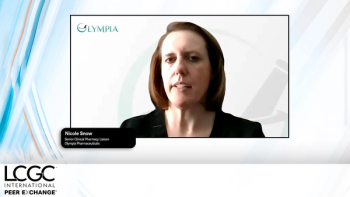
Caroline West, LCGC’s 2015 Emerging Leader Award Winner, Focuses on the Fundamentals of Selectivity
Caroline West, the winner of the 2015 LCGC Emerging Leader in Chromatography award, has a diverse set of scientific interests - in high-performance liquid chromatography (HPLC), supercritical fluid chromatography (SFC), hydrophilic-interaction chromatography (HILIC), and enantioselective separations - but all primarily focused on the fundamentals of chromatographic selectivity.
West, who is an associate professor of analytical chemistry at the University of Orleans in France, has published approximately 50 papers on these topics, including an influential review on graphitic carbon stationary phases, a significant paper that unravels retention mechanisms in the hydrophilic-interaction chromatography (HILIC) mode, and an article on the development of a useful classification of stationary phases for SFC. West recently spoke to LCGC about her scientific beginnings and recent work.
Where or how did your interest in chemistry and analytical chemistry begin?
West: As a young student I was interested in forensics. But that was a long while ago, when “CSI” was not a TV series and nobody knew much about it. So it had the attraction of mystery to me. All I knew was that chemistry, and analytical chemistry in particular, was one way to get to forensics. Later, I did spend some time in a forensics laboratory, working on the analysis of explosives residues, but I did not pursue that field. Instead, I moved on to the fundamentals of chromatography.
You have done some significant research in SFC. How did your project on the classification of SFC stationary phases get started? What were the biggest challenges in creating it, and what benefits does this classification bring to the field?
West: At the time I started my PhD thesis, in 2002, SFC was quite unpopular. I did not receive much encouragement to get involved in this field and rather was met with skepticism, which is a pity because SFC really needs more involvement from academics. I am very happy to say that this is changing now, at least in Europe. Although much has been done in the past, it is clearly not sufficient yet because the way this technique is practiced has changed a great deal over the years. The purpose of my PhD thesis was to investigate the applicability of porous graphitic carbon (PGC) stationary phases in SFC. I wanted to compare PGC to other stationary phases that were more commonly used in SFC, and that is how we ended up building a classification of columns. The biggest challenge was to design a column-testing procedure that would be adequate for a very large range of columns, because we wanted to include the most polar phases (like bare silica) down to the least polar phases (like C18-bonded silica). All of them had to be tested with the same analytes and the same mobile-phase composition. Linear solvation energy relationships (LSER) with Abraham descriptors proved to be an efficient tool in this respect.
I believe that the most important information we gained from this work is that the diversity of selectivities that are available to the SFC chromatographer is extremely wide and strongly dependent on stationary phases. I hope it is helpful to those who are now getting acquainted with the technique, especially in the early steps of method development when a column must be selected. We keep on increasing the list of columns tested whenever interesting ones appear on the market, especially focusing on high-performance stationary phases (such as sub-2-µm particles and superficially porous particles). I hope to make the whole thing available on the internet in an open source format.
What prompted your research into the retention behavior of zwitterionic stationary phases for HILIC? What effect has this research had for HILIC users?
West: Zwitterionic stationary phases were a pretext to investigate HILIC retention mechanisms. I had a feeling that SFC and HILIC mechanisms had a lot in common (a combination of adsorption onto a stationary phase and partition involving a layer of adsorbed mobile-phase components), so I wanted to get a closer look at that. Also, the usual LSER methodology is intended for neutral species, while HILIC required users to take account of ionizable species as well, so some methodological development was necessary there. So we developed a model to describe HILIC retention mechanisms. My underlying thought was that it would be great to use this model for a classification of HILIC systems. I did not have time to do it myself, but I am glad that others (Wolfgang Lindner’s team) have used this idea.
Can you tell us about your research in other areas of separation science such as enantioselective separations?
West: Enantioselective separations have kept me busy for the past five years. While SFC is very successful at it, the general lack of understanding of the enantioseparation processes is a topic of frustration for me. I thought that LSER models again could be helpful in this field. But here too, the usual model is not sufficient because there is nothing in Abraham descriptors to take account of the shape of the molecules. So I introduced two extra descriptors to take account of flexibility and sphericity. They proved to be rather good, we were able to provide some accurate descriptions of retention and separation mechanisms . An immediate application of this work is to compare enantioselective systems - chiral stationary phases, effects of mobile-phase composition, and a comparison of LC and SFC to facilitate method transfer. A future application could be to have some prediction of the chromatographic system best suited to any required enantioresolution. We have had some success with that, but it still needs some improvement.
What research are you the most proud of thus far?
West: Self-satisfaction is not a familiar feeling to me, as I am a real perfectionist. Do not misunderstand me: I do not consider perfectionism a good quality, and it is probably getting worse with time, now that I know that people may read my papers! I can measure the progress I have made in my own understanding of chromatographic processes, and I hope that the work we have published has helped in appreciating the merits of unified SFC for what they really are.
What is your research group currently focused on?
West: We are busy developing high-performance achiral SFC methods for impurity profiling of pharmaceutical compounds. While chiral SFC has long been a favorite in pharmaceutical companies, especially for the purpose of purifying enantiomers at a low cost, it is now being considered for achiral analysis too. In this respect, there are still a number of points that need to be explored in more detail, such as the appropriate operating compositions to ensure both good chromatography and mass spectrometric detection, or the possibility to validate methods to meet the requirements of quality control laboratories.
You have many publications (~50 articles and 1 book chapter) and you have a high h-index (16) for such a young researcher. Is it hard to find the balance between your research and the demands of teaching, supervising PhD and master students, and giving lectures at various universities and conferences?
West: Teaching is somewhat refreshing because it forces me to keep up to date with other analytical chemistry areas that I do not practice in research. However, it also means that my research activities are strongly segmented, and it is difficult to keep focused on your projects when you are often interrupted. This lack of continuity is a great source of exasperation to me because it impairs productivity. The supervision of PhD and master students is also a highly demanding task if you really want to follow their progress and help them improve in their science, thus I prefer to limit their numbers. Students should not suffer from my limited time allowance. This is a two-way commitment: They provide hands and brains, and I must provide education, assistance, and interest in their work.
Do your students’ interests influence the research projects you select?
West: To be honest, I should say that minor projects are brought up by students, while major projects surge from my own desire, but are sometimes influenced by students. I have often noticed that a certain degree of ignorance is an advantage to propose innovative ideas because limited knowledge also implies limited preconceptions. Some students have come to me with an idea and some financial support to carry on with their projects. I accept them when the idea is of interest to me and fits with the projects of our laboratory, and when I know that I can provide access to a machine and will be able to afford sufficient time to the student.
Have you faced any difficulties as a young, female scientist based in Europe?
West: I believe that my difficulties are those encountered by any young woman who wants to have children and be involved in her job. You can do it, but you definitely need some help at home. I consider myself very lucky in the matter. Actually, all the students I have supervised so far have been young women. It was not something I chose; it is simply the result of a large proportion of women in analytical sciences (as compared to other chemistry specialties). They all have been brilliant, so I hope they will not give up science.
What do you plan to focus on next? Is there one big problem in separation science that you really want to tackle?
West: I am interested in the limits of SFC for the analysis of polar molecules, particularly biomolecules. While the way to approach the technique has changed, I expect it will move even further to less carbon dioxide and more water in the mobile phase (that is the other end of the technique, usually called “enhanced-fluidity LC”). And next, when everybody will have been converted to SFC, my job there shall be finished. It will start to be boring to me, so I will move to something very different.
Read more about West here http://www.chromatographyonline.com/2015-lcgc-awards.
Newsletter
Join the global community of analytical scientists who trust LCGC for insights on the latest techniques, trends, and expert solutions in chromatography.





